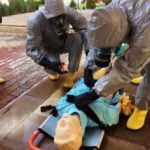Espérance, community relay, mother and pregnant woman is a fine example of volunteerism to the service of the community. Returning from a mission to Mangiva, 2 hours from Bunia in Ituri, I want to share with you the commitment of this young woman of 23 years and mother of Toyabo, 5 years. Espérance supports the families in her village through the thriving community dynamics of the Komanda health zone, in the Ituri province.
Fighting against maternal and infant mortality in DRC
Let us first and foremost acknowledge that Ituri like all the provinces in DR Congo experience a serious public health problem linked to the too many maternal and infant deaths. Mangiva is no exception: many young women die during childbirth at home or at the health facility and many children die before their fifth birthday. “Most of the children fall seriously sick with fevers and diarrhea” says Espérance.
To deal with this problem, the Congolese State, with a particular support from UNICEF, launched the accelerated support Framework for the Millennium Goals 4 and 5 (FMG4&5), in order to reduce maternal and infant mortality. “The FMG4&5 has 4 key points: the community dynamics; the enhanced monitoring for action; the funding based on results; and the supply of medicines” explains Dr. Moulaye Sangaré, Health Specialist in UNICEF in Ituri.
Community dynamics in the health service
In the Ituri province, the community dynamics was established in September 2015. This dynamics focuses on the organization of communities around the participating bodies chosen from members of the community for the activities of awareness on the 15 essential family practices (EFP).
In the village, Kalume Blaise explains the dynamics: “First of all facilitators identified by qualified nurses have sensitized the chief of the village, who has then convened the village into an assembly to elect the community animation Cell (CAC). I was a candidate and I became President of the CAC. We then assembled the Cells into a Health and Development Committee (HDC) of which I was elected President for the Mangiva health center. From there, we started to form community relays (CORE).”
Espérance and community health
Espérance is among the 798 COREs formed within the framework of this project which currently covers five health zones of the Sanitary Provincial Division (SPD) of Ituri with the support of UNICEF assisted by the European Union.
Espérance, like each community relay, was responsible for identifying households with pregnant women and/or children less than 5 years in her community. The relays then follow up on families, their health, and advise them on practices to adopt for their health and relay the problems.
Thus, the day of Espérance, like any good mother after her small house chores, starts with home visits in 40 households to: sensitize them before, during and after distributions of Childbirth kits and IMCI (Integrated Management of Childhood Illness); organize follow-up home visits for newborns and mothers after birth and also pregnant women for prenatal consultation; gather children who have not had all their vaccines; register births by proxy and enroll children by getting the age from school; organize educative talks; and report all the activities and the difficulties and health problems of the village to the CAC at the end of the month.
Like Espérance, André, forty years old, is a relay who is very pleased to participate in the health of his community. “I am chosen by my community and proud to carry this entrusted responsibility during my mandate, for now I am a relay but not forever, therefore I do my work with love in the 40 households that are allotted to me.”
The community dynamics, a success?
This project, which involves the community in the management of its own health, encountered some challenges. According to the Head of the technical support office of the SPD of Ituri, Dr. Jean Luc “the qualified nurses were reluctant at first and thought that the distribution of kits could reduce the attendance of patients to the health centers but it rather encouraged women to give birth in the center.”
The Childbirth Kit provides the necessary material for a safe delivery, with the help of a health professional.
We followed Espérance, our community relay, during her visit to Espérance, a beneficiary of the childbirth kit and today mother of Ornella, a one and a half months old baby. “The kit is a good thing for women, who must contribute to preserve it for good use”.
Blaise Kalume, president of HDC of Mangiva is impressed by the results: “we had 20 deaths of children less than 5 years in June 2016, before the activities of the program, but through the sensitization by the relays and the distribution of kits, we had only 4 deaths in September 2016” this explains the success of this innovative initiative in the area.
Community health: the responsibility of everyone
Is it not wonderful to see such a young and above all pregnant woman dedicating herself with success through volunteerism for the sanitary welfare of the mother and child for a better future? We wish every young person would follow her example to be at the forefront of the interests of our communities.
Fight against mother and child mortality
The “CAO 4&5” program of the Congolese government has been set up with the support of UNICEF, the World Bank, the Vaccine Alliance (GAVI) and the Global Fund. For its implementation, UNICEF is supported by the European Union and, notably, Sweden.
[Source:-Relief Web]






